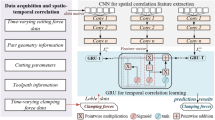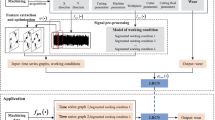Abstract
Improper clamping is one of the major causes of part deformation. Improving the fixture arrangement through force analysis of clamping points is an effective means to suppress or improve machining deformation. However, the existing research focuses on the monitoring and off-line optimization of the clamping point force, which has a certain lag on the machining deformation control, and it is difficult to predict the clamping point force due to the time-varying coupling effect of multiple factors such as process parameters, cutting force, and clamping point force in the machining process. Inspired by the excellent performance of convolutional neural networks and gated recurrent networks in feature extraction and learning of temporal association laws, this paper proposes a CNN-GRU-based method for predicting the force state of clamping points under variable working conditions. Firstly, a force prediction model of clamping point during milling process with variable working conditions is established. Secondly, a convolutional neural network is designed to extract the features of dynamic coupled machining conditions. Then, a network of gated recurrent units is constructed to learn the temporal correlation law between the machining conditions and the forces on the clamping points to achieve force prediction of the clamping points during machining. Finally, it was verified by the milling process of the piston skirt. The results show that CNN-GRU can effectively predict the clamping force. In addition, CNN-GRU has higher computational efficiency and accuracy compared with CNN-LSTM, CNN-RNN and CNN-BP.














Similar content being viewed by others
Availability of data and material
The raw/processed data required to reproduce these findings cannot be shared at this time as the data also forms part of an ongoing study.
References
Diez E, Perez H, Vizan JM, Vizan A (2015) Feasibility Study of In-Process Compensation of Deformations in Flexible Milling. Int J Mach Tools Manuf 94:1–14
Liu C, Li Y, Shen W (2018) A real time machining error compensation method based on dynamic features for cutting force induced elastic deformation in flank milling. Mach Sci Technol 1–21
Liu Z, Wang MY, Wang K, Mei X (2013) Multi-objective optimization design of a fixture layout considering locator displacement and force-deformation. Int J Adv Manuf Technol 67(5–8):1267–1279
Gonzalo O, Seara JM, Guruceta E, Izpizua A, Esparta M, Zamakona I, Uterga N, Aranburu A, Thoelen J (2017) A method to minimize the workpiece deformation using a concept of intelligent fixture. Robot Comput Integr Manuf 48(12):209–218
Li JG, Wang SQ (2017) Distortion caused by residual stresses in machining aeronautical aluminum alloy parts: recent advances. Int J Adv Manuf Syst 89:997–1012
Kurnadi MS, Morehouse J, Melkote SN (2007) A workholding optimization model for turning of ring-shaped parts. Int J Adv Manuf Technol 32(7–8):656–665
Dong ZH, Jiao L, Wang XB, Liang ZQ, Liu ZB, Yi J (2016) Fea-based prediction of machined surface errors for dynamic fixture-workpiece system during milling process. Int J Adv Manuf Syst 85:299–315
Wang JJ, Ma YL, Zhang LB, Gao RX, Wu DZ (2018) Deep Learning for Smart Manufacturing: Methods and Applications. J Manuf Syst 48:144–156
Li YG, Liu CQ, Hao XZ, Gao JX, Maropoulos PG (2015) Responsive fixture design using dynamic product inspection and monitoring technologies for the precision machining of large-scale aerospace parts. CIRP Ann Manuf Technol 64(1):173–176
Hao XZ, Li YG, Li MQ, Liu CQ (2019) A part deformation control method via active pre-deformation based on online monitoring data. Int J Adv Manuf Syst 104(3):2681–2692
Wuest T, Weimer D, Irgens C, Thoben KD (2016) Machine learning in manufacturing: advantages, challenges, and applications. Prod Manuf Res 4(1):23–45
Wang MW, Zhou JT, Gao J, Li ZQ, Li EM (2020) Milling Tool Wear Prediction Method Based on Deep Learning Under Variable Working Conditions. IEEE Access 8:140726–140735
Pimenov DY, Bustillo A, Mikolajczyk T (2017) Artificial intelligence for automatic prediction of required surface roughness by monitoring wear on face mill teeth. J Intell Manuf 29(5):1045–1061
Zhao ZW, Li YG, Liu CQ, Gao J (2019) On-line part deformation prediction based on deep learning. J Intell Manuf 31(3):561–574
Donoho DL (2002) De-noising by soft-thresholding. IEEE Trans Inf Theory 41(3):613–627
Zhang FP, Yan Y, Butt SI (2016) Integrated model based thin-walled part machining precision control for the workpiece-fixture system. Int J Adv Manuf Technol 85(5–8):1745–1758
Dong ZH, Jiao L, Wang XB, Liang ZB, Liu ZB, Yi J (2016) Fea-based prediction of machined surface errors for dynamic fixture-workpiece system during milling process. Int J Adv Manuf Technol 85(1):299–315
Liu S, Shao X, Xiao B, Ge XB, Wang D (2017) Simulation of the deformation caused by the machining cutting force on thin-walled deep cavity parts. Int J Adv Manuf Technol 92(9):3503–3517
Teramoto K (2017) On-machine estimation of workpiece deformation for thin-structured parts machining. International Journal of Automation Technology 11(6):978–983
Hao XZ, Li YG, Zhao ZW, Liu CQ (2018) Dynamic machining process planning incorporating in-process workpiece deformation data for large-size aircraft structural parts. Int J Comput Integr Manuf 32(2):136–147
Wu J, Su YH, Cheng YW, Shao XY, Deng C, Liu C (2018) Multi-sensor information fusion for remaining useful life prediction of machining tools by adaptive network based fuzzy inference system. Appl Soft Comput 68:13–23
Wang XQ, Zhang Y, Zhou HM, Yang FU (2016) Continuous tool wear monitoring based on hidden markov model. Int J Mach Tools Manuf 10:87–90 (in Chinese)
Zhou JT, Zhao X, Gao J (2019) Tool remaining useful life prediction method based on LSTM under variable working conditions. Int J Adv Manuf Technol 104(11):1–12
Tran D, Bourdev L, Fergus R, Torresani L, Paluri M (2014) Learning spatiotemporal features with 3d convolutional networks. Proc IEEE Int Conf Comput Vis 4489–4497
Elman JL (1990) Finding structure in time. Cogn Sci 14(2):179–211
Hochreiter S, Schmidhuber J (1997) LSTM can solve hard long time lag problems. Adv Neural Inf Process Syst 473–479
Chung JY, Gulcehre C, Cho KH, BengioY (2014) Empirical evaluation of gated recurrent neural networks on sequence modeling. arXiv:1412.3555
Li Z, Li JY, Wang Y, Wang KS (2019) A deep learning approach for anomaly detection based on SAE and LSTM in mechanical equipment. Int J Adv Manuf Syst 103(1–4):499–510
Zhao R, Wang D, Yan R, Mao K, Wang J (2017) Machine health monitoring using local feature-based gated recurrent unit networks. IEEE Trans Industr Electron 65(2):1539–1548
Zhao RM, Cui HM, Hou YL (2012) Improved threshold denoising method based on wavelet transform. Phys Procedia 33:1354–1359
Xie ZJ, Song BY, Zhang Y, Zhang F (2014) Application of an Improved Wavelet Threshold Denoising Method for Vibration Signal Processing. Adv Mat Res 889–890:799–806
Zhang W, Guoxiang S (2004) Wavelet domain signal denoising based on a new threshold function. J Xi’an Univ Elect Sci Technol 31(2):296–299 (in Chinese)
Shao H (2016) Data-based short-term wind speed prediction for wind farms. Dissertation, Southeastern University. arXiv:1412.6806
Springenberg JT, Dosovitskiy A, Brox T, Riedmiller M (2014) Striving for Simplicity: The All Convolutional Net
Wang L, Si H (2018) Machining deformation prediction of thin-walled workpieces in five-axis flank milling. Int J Adv Manuf Syst 97(9):4179–4193
Funding
This research was supported by the National Key R&D Program of China (No. 2019YFB1703800).
Author information
Authors and Affiliations
Contributions
Enming Li conceived of research methods, performed the experiments, and wrote the manuscript. All authors contributed to collect and analyze the data, also revisions.
Corresponding authors
Ethics declarations
Ethics approval
Not applicable.
Consent to participate
Not applicable.
Consent for publication
Not applicable.
Additional information
Publisher's Note
Springer Nature remains neutral with regard to jurisdictional claims in published maps and institutional affiliations.
Rights and permissions
About this article
Cite this article
Li, E., Zhou, J., Yang, C. et al. CNN-GRU network-based force prediction approach for variable working condition milling clamping points of deformable parts. Int J Adv Manuf Technol 119, 7843–7863 (2022). https://doi.org/10.1007/s00170-021-08520-2
Received:
Accepted:
Published:
Issue Date:
DOI: https://doi.org/10.1007/s00170-021-08520-2




